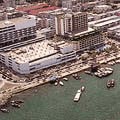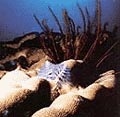|
|
|
Kota Kinabalu
 As
Sabah's capital, Kota Kinabalu (or KK as called by the locals) sits on
the edge of the South China Sea overlooking a cluster of coral-fringed
islands. One of Asia's fastest growing cities, KK is an interesting blend
of European, Malay, and Chinese culture. Recent influx of Filipinos has
added extra flavor to the existing cultural blend. KK is a modern city
with a number of shopping complexes, and international hotels and restaurants. As
Sabah's capital, Kota Kinabalu (or KK as called by the locals) sits on
the edge of the South China Sea overlooking a cluster of coral-fringed
islands. One of Asia's fastest growing cities, KK is an interesting blend
of European, Malay, and Chinese culture. Recent influx of Filipinos has
added extra flavor to the existing cultural blend. KK is a modern city
with a number of shopping complexes, and international hotels and restaurants.
• Please
visit Mount Kinabalu
under Highlands and Kinabalu
Park under National Parks.
Tunku
Abdul Rahman National Park
 A
group of five almost untouched islands - Pulau Gaya, Pulau Sapi, Pulau
Mamutik, Pulau Manukan, and Pulau Sulug - make up the Tunku Abdul Rahman
National Park. Located between 3 to 8km from Kota Kinabalu, the islands
are a favorite among picnickers, divers, and nature lovers. In order to
protect the natural environment with its coral reefs, marine life, and
its flora and fauna, the islands were gazetted as a National Park. Only
a short boat ride from the city center, they offer some of the best beaches
in Borneo with crystal clear waters and a wealth of corals and tropical
marine life. Pulau Gaya is the largest island in the park whereas Manukan
is the second largest. The latter is also the only island with accommodation
facilities. more... A
group of five almost untouched islands - Pulau Gaya, Pulau Sapi, Pulau
Mamutik, Pulau Manukan, and Pulau Sulug - make up the Tunku Abdul Rahman
National Park. Located between 3 to 8km from Kota Kinabalu, the islands
are a favorite among picnickers, divers, and nature lovers. In order to
protect the natural environment with its coral reefs, marine life, and
its flora and fauna, the islands were gazetted as a National Park. Only
a short boat ride from the city center, they offer some of the best beaches
in Borneo with crystal clear waters and a wealth of corals and tropical
marine life. Pulau Gaya is the largest island in the park whereas Manukan
is the second largest. The latter is also the only island with accommodation
facilities. more...
Pulau
Layang-Layang
 A
diver's paradise, Sabah's Layang-Layang is actually a new name for an
oceanic atoll once called "Swallow Reefs". Situated approximately 300km
northwest of KK, Layang-Layang is a tiny oceanic island surrounded by
a coral atoll. It is among the famous Spratlys, which is a collection
of about 600 islands, reefs, and atolls strategically located in the South
China Sea. A
diver's paradise, Sabah's Layang-Layang is actually a new name for an
oceanic atoll once called "Swallow Reefs". Situated approximately 300km
northwest of KK, Layang-Layang is a tiny oceanic island surrounded by
a coral atoll. It is among the famous Spratlys, which is a collection
of about 600 islands, reefs, and atolls strategically located in the South
China Sea.
• Please
visit Pulau Layang-Layang
under Islands.
Crocker
Range
 The
Crocker Range is the backbone of western Sabah as it divides the western
coastal plains from the rest of Sabah. Lying more than 300m above sea
level, it is spread over 139,919 hectares of densely forested terrain.
It rises from near Tenom in the south and culminates in the north at Mount
Kinabalu and Mount Trus Madi. The fertile coastal plain on which KK and
other large settlements developed are situated nearly 1500m below the
range. Roads crossing the range have made the interior more accessible
from coastal areas, thus making it possible for visitors to enjoy the
serene tranquility in the rugged mountains. Although logging has taken
a toll on some parts of Sabah, Crocker Range still has intact forest and
much of it is now preserved as the Crocker Range National Park. Presently,
there are visitor facilities within the park and it is also not open for
public visits. Those who intend to visit must obtain written permission
from the Director of Sabah Parks. The
Crocker Range is the backbone of western Sabah as it divides the western
coastal plains from the rest of Sabah. Lying more than 300m above sea
level, it is spread over 139,919 hectares of densely forested terrain.
It rises from near Tenom in the south and culminates in the north at Mount
Kinabalu and Mount Trus Madi. The fertile coastal plain on which KK and
other large settlements developed are situated nearly 1500m below the
range. Roads crossing the range have made the interior more accessible
from coastal areas, thus making it possible for visitors to enjoy the
serene tranquility in the rugged mountains. Although logging has taken
a toll on some parts of Sabah, Crocker Range still has intact forest and
much of it is now preserved as the Crocker Range National Park. Presently,
there are visitor facilities within the park and it is also not open for
public visits. Those who intend to visit must obtain written permission
from the Director of Sabah Parks.
Rafflesia
Forest Reserve
 The
Rafflesia Forest Reserve is devoted to the world's largest flower. The
rafflesia is a parasite plant that grows hidden within its host, which
are the stems of jungle vines, until it busts into bloom. In many respects,
this colorful flower is strange and baffling. It blooms as a single flower,
which has no roots, no stem, and no leaves as well. This large, magnificent
flower is able to grow up to 1m in diameter. The 12 or so species of rafflesias
are found only in Borneo and Sumatra. There are several species that are
unique to Sabah but their blooming is unpredictable. The
Rafflesia Forest Reserve is devoted to the world's largest flower. The
rafflesia is a parasite plant that grows hidden within its host, which
are the stems of jungle vines, until it busts into bloom. In many respects,
this colorful flower is strange and baffling. It blooms as a single flower,
which has no roots, no stem, and no leaves as well. This large, magnificent
flower is able to grow up to 1m in diameter. The 12 or so species of rafflesias
are found only in Borneo and Sumatra. There are several species that are
unique to Sabah but their blooming is unpredictable.
The reserve gives us the opportunity to
see this floral wonder. The Rafflesia Information Centre, which is located
at the entrance of the reserve, has interesting displays and information
devoted to the flower. It provides facts and advice about the flower,
including where, when, and how to see them. From the center, trails lead
into the forest where the flowers can be found. The flowers may be located
close to the information centre or they may be deep in the forest. It
is all a matter of luck and patience!
Top of Page
|
